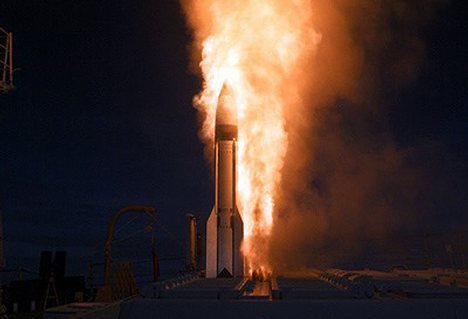A Raytheon Company (NYSE: RTN) Standard Missile-3 Block IA fired from the USS Lake Erie destroyed a medium-range ballistic missile (MRBM) target using tracking data from a remote Raytheon sensor payload on the Space Tracking and Surveillance System-Demonstrator (STSS-D) satellites.
“This test further expands our confidence in the SM-3’s ability to engage targets using remote, netted sensor targeting,” said Wes Kremer, Raytheon Missile Systems’ vice president of Air and Missile Defense Systems. “Launching on remote is important because it extends the engagement range of the missile, allowing ships with the SM-3 to expand the battlespace and eliminate threats sooner.”
The MRBM target was launched from the Pacific Missile Range Facility. As it rose above the horizon, the target was acquired and tracked by STSS-D. Threat data was then relayed through the Command, Control, Battle Management and Communications (C2BMC) system to the ship. The ship’s crew fired the SM-3 based on STSS track data and before the ship’s radar acquired the target.
“STSS-D’s unique vantage point in space allows the sensor payload to see the threat early in its trajectory and provide launch quality data sooner than nearly any other option,” said Bill Hart, vice president of Space Systems for Raytheon’s Space and Airborne Systems business. “We can give our naval warfighters extra time to analyze and respond, by providing target data before the ship can track the threat. That’s a tremendous advantage.”
The test proves the “launch on remote” concept, which was first demonstrated during testing in April 2011 when a U.S. Navy destroyer used track data provided by a Raytheon-made AN/TPY-2 radar deployed on Wake Island to engage and destroy an intermediate-range ballistic missile target using an SM-3 Block IA.
About the Standard Missile-3
The SM-3 guided missile is designed to destroy incoming short-, medium-, and intermediate-range ballistic missile threats by colliding with them in space, a concept sometimes described as “hitting a bullet with a bullet.” The missile does not contain an explosive warhead, but instead destroys the threats using sheer impact, equivalent to a 10-ton truck traveling at 600 mph.
- More than 135 SM-3s have been delivered to U.S. and Japanese navies ahead of schedule and under cost.
- Raytheon is on track to deliver the next-generation SM-3 Block IB guided missile in 2014.
- SM-3 Block IB guided missile will be deployed in both afloat and ashore weapons systems.
- The test marks the 22nd successful intercept for the SM-3 program.
About the Space Tracking and Surveillance System-Demonstrator Satellites
STSS-D is a research and development capability for the Ballistic Missile Defense System that can detect and track ballistic missiles and other cold objects in space. Raytheon sensors used on the payloads were developed under contract to Northrop Grumman, prime contractor for the STSS-D program.
- STSS-D consists of two satellites carrying sensor payloads in a low-Earth orbit.
- The satellites demonstrate the value of space-based sensors to missile defense.
- The STSS-D payloads are able to detect infrared and visible light.










